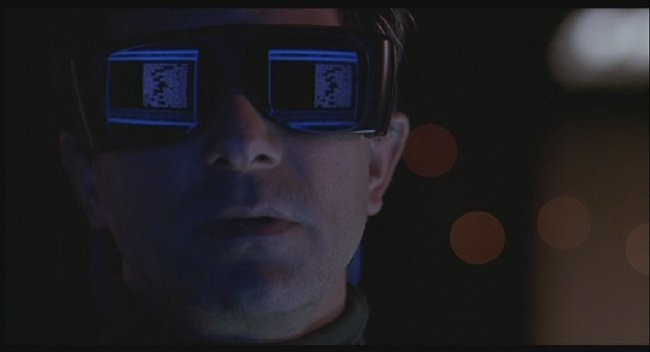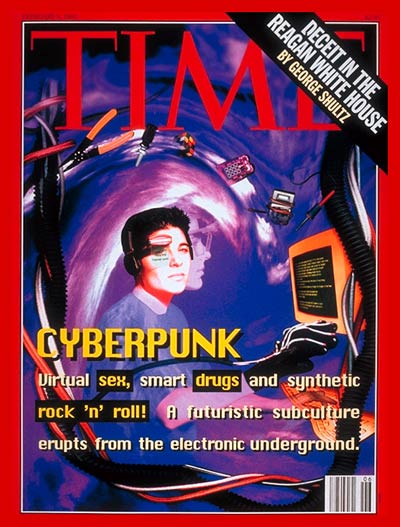August 17, 2007
The Four Eras of Cyberpunk
The Four Whatsits of Cyberpunk? Sometimes, to understand history better, historians may divide a certain time period by key events or arbitrary dates. This allows them to study easier-to-manage chunks in detail that can then be connected together to show a bigger picture. This is helpful whenever studying time periods as long as an ice age or as brief as cyberpunk’s existence.
My personal knowledge and study of cyberpunk history has led me to make such divisions to create four eras of cyberpunk as described below. While some may say there may be only three eras, arguing that cyberpunk didn’t exist during the “Prototype Era,” I feel this period is relevant since certain key events occur here that do affect the formation of cyberpunk.
And now, to help further your education in cyberpunk, I present the four eras in chronological order:

So much history to draw from, plenty of material to inspire the movement. But could cyberpunk exist without the invention of computers? Probably not, like it couldn’t exist without the 60s counter-cultural revolution or the 70s punk rage, or even the rise of AT&T to monopoly status. Yet nobody from this era could ever guess that computers, once technology made them small and affordable enough for home use, would come to dominate the future. As such, media of the time would touch on themes of humanity and societal control as seen in works like Do Androids Dream of Electric Sheep?, A Clockwork Orange, Fahrenheit 451, THX-1138, The Shockwave Rider, and Metropolis. These would become some of the influential forces that would shape the movement to come.

When Bruce Bethke invented the word “Cyberpunk” for a short story in 1980, he never expected it to be attached to a major movement; He just wanted to make a memorable title. As such, when the Washington Post used it to describe the group of science fiction writers like Gibson, the name sticks to and becomes synonymous with all that came attached to it… and Bruce is left wishing he had trademarked the word.
It seems that 1981 is a critically important year to the cyberpunk movement. During that year the IBM PC appears on the home computer market (and the market hasn’t been the same since), Kraftwerk releases the album “Computer World” aka “Computerwelt” in Germany, William Gibson’s short stories “The Gernsback Continuum” and “Johnny Mnemonic” are published, and most importantly, Gibson sends Ace Books an outline for a novel called “Jacked In,” which would later become Neuromancer.
With the success of the IBM PC and game consoles like the Atari 2600 VCS in the homes, computer technology would begin ramping up to give better graphics and faster systems to handle them. Could this tech explosion have been the result of cyberpunk sci-fi? Did fans of Neuromancer trigger the information age? Or was the computer revolution an inevitable outcome of technology’s progress? That chicken-or-egg question may never be fully answered, but cyberpunks only care that the technology was advancing and not being used to suppress, oppress, repress, or depress. Besides, they had some cool new toys to play with.
Most people probably never heard of the word “cyberpunk” or what it represents, until Time Magazine’s cover article “Cyberpunk” in February 1993 or Billy Idol’s “Cyberpunk” CD in July 1993. That year, the term and the movement was no longer underground; It was now injected into the mainstream consciousness. And Hollywood was quick to take advantage. In 1995, some five cyberpunk movies were released, though most failed only to become favorites among cyberpunk fans. Also in 1995, The Cyberpunk Handbook is published giving the clueless and curious a look into what the movement was at the time.
During this time, something else was happening to the cyberpunk movement… it was slowly dying. Some blamed Billy Idol and Time Magazine, others blamed Hollywood and Johnny Mnemonic, and most blamed the mainstreaming of the movement for its downfall. Whatever the cause, it seemed that stagnation, and possibly confusion, was affecting what was once a vibrant movement. There was a dire need for something fresh… and in 1999, they got a much needed infusion.

When The Matrix hit the theaters, it gave the cyberpunk genre a new generation of jacked-in fans. During that same year, another phenomenon was occurring that showed how pervasive computers became in society. It was known as the Y2K bug, a problem in programming where only two digits were used to represent the year. Technicians and programmers worked feverishly to correct a potentially disastrous situation. It was feared that when the clock struck midnight on December 31, computers would mistakenly read the year as “1900″ instead of “2000,” triggering global chaos and destruction because of the confusion. It never happened, though there were reports of someone being charged a quarter-million dollars for a video rental due to the bug.
There is another phenomenon happening during this current era. Cyberpunk is no longer restricted to printed pages, it is now a part of real time life as megacorporations, hackers, rapidly advancing technology, and forces seeking total control over society are now daily news makers. Some say that all this is the result of the terrorist attacks of September 11, 2001 as the resulting “Patriot Act” gave way to FBI and NSA spying programs and the revelation of room 641A in San Francisco, the NSAT&T wiretap hub. There’s also the growing power of megacorporations like Microsoft, Apple, Google, and AT&T (who recently showed that power during a Pearl Jam concert) in their ongoing quests for world domination, Internet control, and total information awareness.
On the positive side, there have been advances in cybernetics, biology, and nanotechnology that have resulted in better medical possibilities, prosthetics that more accurately mimic real limbs, cloning that can replicate new replacement organs, and human-machine interfaces that were only dreamed about during the writing of Neuromancer. If cyberpunk is dead as a media movement, it has a bright future as reality.
Individual Results May Vary: This isn’t by any means meant to be a definitive ruling on the history of cyberpunk. There will be some disagreement to some of the dates used, like whether the Movement Era should start somewhere between 1981 and 1984 to coincide with the publication of “The Gernsback Continuum” (1981), the release of the movie Blade Runner (1982), the actual publication of Bruce Bethke’s “Cyberpunk!” (1983), or the publication of Neuromancer (1984). Also, the exact year that cyberpunk went mainstream is questionable; Was it 1993 (for Time Magazine and Billy Idol) or 1995 (for Hollywood’s want to milk a potential cash cow)? A detailed history of cyberpunk can be found on our CyberpunkWiki here if you want to see the whole time line and the key events that made cyberpunk what it is today.
One thing is certain: With word of a Neuromancer movie due 2008-09, if the movie is released it will either signal the start of a new era or the end of the movement. Stay jacked in, the future is yet to come…

Comments
August 17, 2007
Are we living in the post-Cyberpunk era? « cyberpunk2020 said (pingback):
[…] we living in the post-Cyberpunk era? Mr. Roboto seems to think so. And he has some good […]
kingnecros said:
A good treatise. Covers all the important tech and societal advances up to present.
August 18, 2007
Laddie said:
“If cyberpunk is dead as a media movement, it has a bright future as reality.”
Yeap.
Great article, sir.
Nerdcore — links for 2007-08-18 said (pingback):
[…] The Four Eras of Cyberpunk […]
Hammerjack said:
It’s THX-1138… not THX-1137
caprison said:
Nice write up. It was an enjoyable read and accurate from my perspective. Hope to see more.
christian schorn » Blog Archive » links for 2007-08-18 said (pingback):
[…] Ein wenig Cyberpunk-Geschichte (tags: literatur sf cyberpunk) […]
August 21, 2007
Merzmensch said:
Great chronology!
(Post-Matrix Era:)
Also “Second life” (”Snow crash”, hehe) did something important for mainstream:
If in earlear eras only pc-freaks/hackerz/and other strange people were the demiurgs of the virtuality, in “Post-Matrix-Era” are also “normal” people not only receptors of CP-thematical works, but are also involved in the developement of one central vison by Cyberpunk theoreticians: the connected world, which atoms’ name is bit, and which material is information.
September 1, 2007
drewmerc said:
the rise of at&t important…no sorry its not
remember not everybody is a yank
September 4, 2007
Kmuzu said:
Excellent .. just really excellent .. you actually brought a slight tear to my eye with Bush steals the election.
Kmuzu
Kmuzu said:
AT&T was in USA, Canada, Mexico, Cuba, Australia and most of the Middle East. I worked for an Australian company and it was filled with AT&T expats.
Microsoft is now the new AT&T and probably Google will be the new Microsoft.
Kmuzu
September 12, 2007
Cynx Cynical World said (trackback):
Cyberpunk Update…
Ausgelöst durch die verzweifelte Suche des Doktors (ich verkneife mir jetzt jeden Scherz mit “Who?”) nach Cyberpunk-Beiträgen werfe ich jetzt mal so alles zusammen was immer noch darauf wartet von mir gebloggt zu werden:
Der Cyberpunk Review sch…
theory.isthereason » Today’s Links: Online Influence, Tools and Science said (pingback):
[…] The Four Eras of Cyberpunk To understand history better, historians may divide a certain time period by key events or arbitrary dates. This allows them to study easier-to-manage chunks in detail that can then be connected together to show a bigger picture. Keywords: history, culture, internet Readership (2) | […]
October 11, 2007
Terminal Reality said:
Excellent writing again sfam.
July 26, 2008
Sean said:
>>”Cyberpunk theoreticians”